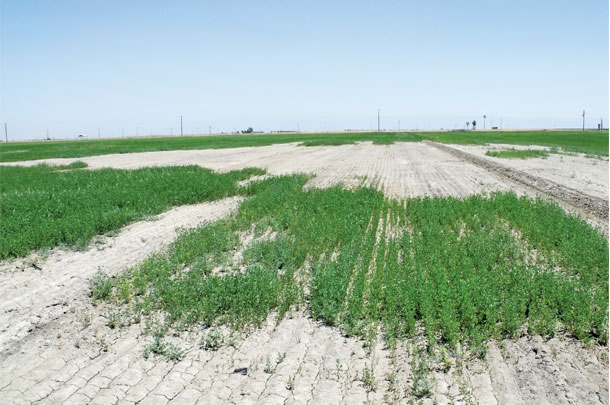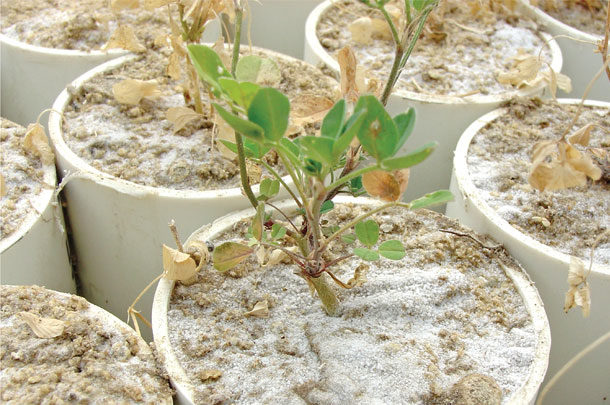How big is the salinity problem? Salinity and its detrimental effect on agriculture is not a new problem.
When man first started irrigating crops, he soon learned that long-term irrigation eventually resulted in the increase in soil salinity and lower crop yields. History is filled with examples of once-productive farmland that, over time, became marginal farmland due to salt buildup. This ongoing problem of increasing salinity has been referred to as one of the most significant problems facing agriculture today.
Saline soils occur in many parts of the U.S., ranging from the Dakotas to the arid Southwest, and are especially prevalent anywhere there is irrigated agriculture. According to documentation from the USDA’s U.S. Salinity Laboratory, yield reductions due to salinity occur on an estimated 30% of all irrigated land in the U.S. In 2000, 35.6% of California’s irrigated farmland was classified as saline soils (soil electrical conductivity [EC] greater than 4). The USDA has estimated 300,000 acres in Montana have been removed from production because of increased salinity.
Typical yield loss estimates due to salinity in salt-affected regions are generally in the range of 25%. Non-salt-tolerant alfalfa varieties lose 7.5% of their yield for each point above EC=2. It is estimated the U.S. loses about 7.4 acres per day to soil salinization.

The top 14 states with salt-affected acres (in millions) are: North Dakota (9.4), South Dakota (9.1), Montana (6.9), Texas (4.5), California (3.6), Minnesota (2.8), Colorado (1.8), Idaho (1.7), Kansas (1.2), Utah (1.1), Wyoming (1.1), Nevada (0.8), Arizona (0.8) and New Mexico (0.7).
How do salts accumulate?
Water tables: The buildup of soil salts in agriculture comes from several sources. In regions like Montana and the Dakotas, “saline seeps” are often the source of the saline problem, where high water tables bring salts to the surface. Saline seeps trace their salts to the weathering of soil parent material that originated from deposits of ancient inland seas. Poor drainage practices, excessive irrigation or rainfall, and cropping practices such as winter fallowing can contribute to high water tables that result in soil salt buildup at the soil surface in the form of saline seeps.
Irrigation: One of the most common sources of soil salts is from irrigation water. Most if not all irrigation water contains some level of salt, whereas rainwater is relatively free of salts. It has been said that inevitably, irrigation leads to the salinization of soil and water, and that all irrigated farm ground will eventually have to be managed for salt. It has been reported that the California aqueduct irrigation water deposits 0.3 tons of salt for each acre-foot of water applied. A full irrigation season using 4 acre-feet of water deposits 1.2 tons of salt per acre.
In irrigated forage production regions, the salinity problem is also increasing as farmers move from flood irrigation to sprinkler irrigation as a means of improving irrigation efficiency to manage limited water sources. Sprinkler irrigation applies significantly less water and as a result salts stay near the soil surface as compared to flood irrigation, which tends to leach the salts down below the root zone.
Soil amendments such as chemical fertilizers and/or manure can also contribute salts to the soil. Dairy operations must dispose of large quantities of manure in their daily operations. It has been reported that a high-producing dairy animal produces 4 pounds of salt per day in their manure, which when used as fertilizer could add significant amounts of salts to fields.
Where do salt-tolerant alfalfa varieties fit?
There is a significant amount of farmland in the U.S. classified as marginally saline that can be better utilized by producers. Farmers in those affected areas often see portions of their fields become more and more unproductive due to the buildup of salt over time. As a result, only high-value crops such as corn and soybeans are reserved for the least saline farm ground.
The utilization of the marginal land is becoming more and more critical to farmers and ranchers as they try to maximize profits on the land they have available to them. Salt-tolerant alfalfa varieties could have an increasing role in making less desirable farmland more profitable. Although improved genetic lines are unlikely to be highly productive on the most severe saline soils, they can be beneficial in increasing stands and yield on marginally saline soils. The development of new improved salt-tolerant alfalfa varieties has given forage producers a new means of combating salinity and minimizing salinity-related production losses and an opportunity to improve profits by more fully utilizing more of their farm ground.
Saline-tolerant alfalfa is a good fit for hay production regions that need a productive crop in saline seep or irrigated regions where the buildup of salts is becoming a large factor. Benefits will also be seen as water quality is affected by saline content due to drought conditions that contribute to higher river salts and less available water to leach salts out of the root zone.
Summary
More and more farmland is being affected by increasing salinity. As a result, only high-value crops are being planted on the least saline ground. The advent of salt-tolerant alfalfa varieties provides producers with another crop option for these salt-affected cropping systems. The advantages of salt-tolerant alfalfa varieties is twofold: They have the genetic flexibility to produce top yields in non-saline soils as well as improved performance on marginally saline soils. This makes alfalfa hay production a viable option for crop rotations in saline-affected regions of the country. The ability to produce crops on farm ground ranging from good to marginal has the potential to increase overall farm revenue, and saline-tolerant alfalfa production fits this role very well. ![]()
PHOTO 1: Plants are stressed with salt to determine tolerance and aid plant selection in variety development.
PHOTO 2: High-salinity soil shows its effects on this California alfalfa field. Photos courtesy of Don Miller.

-
Don Miller
- Product Development Director
- Alforex Seeds
- Email Don Miller












